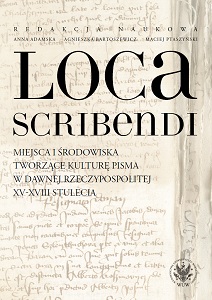„Nietypowe” miejsca aktów prawnych rejestrowanych w księgach czynności biskupa poznańskiego Andrzeja Bnińskiego (1438–1479)
‘Atypical’ places of legal action, recorded in the registers of Andrzej Bniński, Bishop of Poznań (1438–1479)
Author(s): Paweł Dembiński
Subject(s): Middle Ages, 6th to 12th Centuries, 13th to 14th Centuries, 15th Century, 16th Century, 17th Century, 18th Century
Published by: Wydawnictwa Uniwersytetu Warszawskiego
Keywords: writing community; consistory; notary public; writer; writing; office; books; 15th-18th century; writing culture
Summary/Abstract: This article investigates ‘atypical’ places of legal action and of the production of legal records, registered in the Acta episcopalia produced under the rule of Andrzej Bniński, Bishop of Poznań (1438–1479). Three volumes of these acta (altogether 815 folios), embracing almost all of the bishop’s pontificate, have been investigated. Only a minute part of the notes recording legal actions have been edited by modern scholars, and many entries contain substantial omissions. The specific characteristics of the source’s materials are discussed, a.o. the general absence of information about administering the sacraments, the dedication of churches and chapels, etc. Next, the organisation of the episcopal chancery and the government of the diocese is explained. The daily routine of administration consisted of constant tours of the large diocese, which in the 15th century embraced the western frontier areas of the Polish kingdom (i.e. the western part of Greater Poland) and a big enclave in Mazovia. The places are analysed where the bishop (or the notaries working under his authority) used to work. These were halls (called pallacium), large rooms on the first floor of episcopal buildings (sala superior), ‘white chambers’ (stuba alba), ‘large chambers’ (stuba maior), rooms with a chimney (caminata) as well as alcoves (cubiculum) and ‘black chambers’ (stuba nigra). All these places were located in the episcopal residences, and also in monasteries and residences of local nobles who received the bishop on his travels. Episcopal notaries also acted in the chambers of the rectories in villages situated on episcopal estates or in other settlements in which the bishop happened to stay. ‘Atypical’ seem the recordings of the performance of his administrative duties by the bishop (or his officials) which had a public character, or at least occurred in places accessible to everybody. The most clear cases concern situations in which episcopal power had to be manifest, e.g. judging Hussites in church buildings, solemnly confirming pious donations, or introducing someone into ecclesiastical office. Some legal actions were performed in public to gather as large a number of witnesses as possible at court sessions. Large audiences were welcome to avoid accusations of secret (and therefore suspicious) activities. Finally, the practice of making legal actions public might result from the personal preferences of the bishop. In spring and summer, he clearly preferred to receive visitors in the garden, over a meal, and maybe also to entertain his entourage. The sources also mention occasions when the bishop was troubled by petitioners just as he and his cortege were leaving. Episcopal notaries, who had to be permanently on standby and worked around the clock, could also be besieged by petitioners when they were on the move. The choice of the place of legal action might also be influenced by the social status of the petitioners. Although the places of legal actions (loca actandi) were carefully identified in the sources, sometimes it is difficult to establish when exactly the entries in the episcopal registers were made: on the spot, at the place of the legal action, or rather later on, in a quiet room, on the basis of minutes taken earlier.
- Page Range: 152-170
- Page Count: 19
- Publication Year: 2017
- Language: Polish
- Content File-PDF

